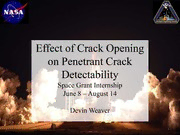
NASA Technical Reports Server (NTRS) 20090035815: Effect of Crack Opening on Penetrant Crack Detectability PDF
Preview NASA Technical Reports Server (NTRS) 20090035815: Effect of Crack Opening on Penetrant Crack Detectability
Effect of Crack Opening on Penetrant Crack Detectability Space Grant Internship June 8 — August 14 Devin Weaver t I0 Agenda • Personal Background • Background Information • Project Outline • Project Procedure • Results • Conclusion &Future Work • What I Have Learned • The Near Future • Acknowledgements and References Z Personal Background Mechanical Engineering Graduate in May 2010 Michigan - New York Iowa Pennsyly is _ Ohio Illinois Indiana New Jersey ryland West K as Missouri Virginia Delaware ' Kentucky irginia Tennessee North Oklahoma Carolina Arkansas South ° Wiminylon Mississippi Carolina labama Georgia Texas Austino''t -' - ,- oJacksonville 3 0 Sano Houston ONrleewans Background Non Destructive Evaluation (NDE) Fluorescent Penetrant Testing Eddy Current Testing Penetrant Metal Cleaned Surface Developer 4 Background Probability of Detection (POD) • Quantitative measure of the 1 efficiency of an NDE procedure in finding flaws ° of specific type and size Z • The goal is to find a crack ° W° length for which there is o o 90% chance of detection with a 95% confidence ° co a • NASA uses a 29/29 criteria 0 a while the Air Force uses ° regression analyses • The JSC NDE lab has several 0 sets of POD specimens ° 100 200 300 5 CRACK LENGTH (MILS) Background JSC Titanium POD Specimens • Semi-circular grooves cut into 4"x18" Ti Bar • EDM slots placed in rib between grooves • Fatigue cracks created by bending • The groves were machined off after cracking • Surfaced etched to remove smeared metal that was covering the cracks Background Why? • A NASA contractor required to pass POD test to build pressure vessels for Mars Science Laboratory • Another NASA contractor could not find ultra-tight 41 cracks in shuttle FCV poppets using fluorescent penetrant — Rely on eddy current testing to approve poppets for flight — Researching root cause of cracks at WSTF Background JSC Titanium POD Specimens Cont' • Assessment of Contractor's 2008 qualification testing generated several questions about the quality of JSC's POD specimens • JSC's POD specimens have "V" shape from etching • Do not know how the width of the crack opening affects the crack detectability • Cracks were contaminated with debris after returned to JSC from the Contractor S Project Outline Penetrant Procedure How UU„ How clean and comparable are detectable are Cracl POD cracks the POD and in-service Openii cracks? cracks? Are the poppet cracks too tight for penetrant? 9 Project Procedure "V" Investigation • Cut out ill with the crack centered using diamond cut-off saw • Document initial condition with SEM • Perform Fluorescent penetrant — Spot of penetrant covering crack, P-136E — 15 — 30 minute dwell time — Dry wipe and solvent wipe — Photograph pre-developed state — Apply developer from aerosol spray can — Photograph post-developed state — Dry wipe off developer and repeat development process if necessary — Clean specimen 10
